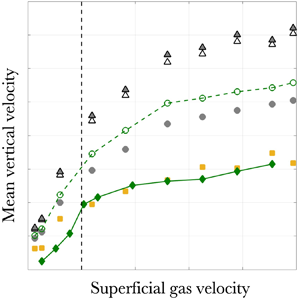Article contents
Buoyancy-driven bubbly flows: role of meso-scale structures on the relative motion between phases in bubble columns operated in the heterogeneous regime
Published online by Cambridge University Press: 17 May 2023
Abstract

The hydrodynamics of bubble columns in the heterogeneous regime is investigated from experiments with bubbles at large particle Reynolds numbers and without coalescence. The void fraction field  $\varepsilon$ at small scales, analysed with Voronoï tessellations, corresponds to a random Poisson process (RPP) in homogeneous conditions but it significantly differs from an RPP in the heterogeneous regime. The distance to an RPP allows identifying meso-scale structures, namely clusters, void regions and intermediate regions. A series of arguments demonstrate that the bubble motion is driven by the dynamics of these structures. Notably, bubbles in clusters (respectively in intermediate regions) are moving up faster, up to 3.5 (respectively 2) times the terminal velocity, than bubbles in void regions whose absolute velocity equals the mean liquid velocity. In addition, the mean unconditional relative velocity of bubbles is recovered from mean relative velocities conditional to meso-scale structures, weighted by the proportion of bubbles in each structure. Assuming buoyancy–inertia equilibrium for each structure, the relative velocity is related to the characteristic size and concentration of meso-scale structures. By considering the latter quantity's values at large gas superficial velocities, a cartoon of the internal flow structure is proposed. Arguments are proposed to help understanding why the relative velocity scales as
$\varepsilon$ at small scales, analysed with Voronoï tessellations, corresponds to a random Poisson process (RPP) in homogeneous conditions but it significantly differs from an RPP in the heterogeneous regime. The distance to an RPP allows identifying meso-scale structures, namely clusters, void regions and intermediate regions. A series of arguments demonstrate that the bubble motion is driven by the dynamics of these structures. Notably, bubbles in clusters (respectively in intermediate regions) are moving up faster, up to 3.5 (respectively 2) times the terminal velocity, than bubbles in void regions whose absolute velocity equals the mean liquid velocity. In addition, the mean unconditional relative velocity of bubbles is recovered from mean relative velocities conditional to meso-scale structures, weighted by the proportion of bubbles in each structure. Assuming buoyancy–inertia equilibrium for each structure, the relative velocity is related to the characteristic size and concentration of meso-scale structures. By considering the latter quantity's values at large gas superficial velocities, a cartoon of the internal flow structure is proposed. Arguments are proposed to help understanding why the relative velocity scales as  $(gD\varepsilon )^{1/2}$ (with
$(gD\varepsilon )^{1/2}$ (with  $D$ the column's diameter and
$D$ the column's diameter and  $g$ gravity's acceleration). The proposed cartoon seems consistent with a fast-track mechanism that, for the moderate Rouse numbers studied, leads to liquid velocity fluctuations proportional to the relative velocity. The potential impact of coalescence on the above analysis is also commented.
$g$ gravity's acceleration). The proposed cartoon seems consistent with a fast-track mechanism that, for the moderate Rouse numbers studied, leads to liquid velocity fluctuations proportional to the relative velocity. The potential impact of coalescence on the above analysis is also commented.
Information
- Type
- JFM Papers
- Information
- Copyright
- © The Author(s), 2023. Published by Cambridge University Press
References
- 5
- Cited by


